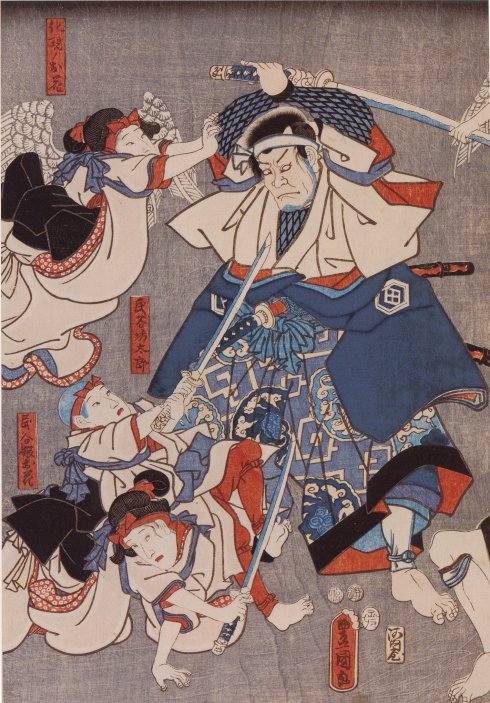An iconographic and text archive related to communication, technology and art.
☛ The Nature of Photographs by Stephen Shore (New York:Phaidon, Second edition, [1998]2007, p. 65): “Scene from Kabuki play” by Toyokuni III (Kunisada), c.1850.
Here are the comments offered by Stephen Shore in his book:
Japanese woodblock prints use the frame in a way that is more reminiscent of photographs than of Western painting. It has been suggested that this was a result of the Eastern scroll tradition – seeing the infinitely variable croppings that occur when viewing a scroll as it is rolled from hand to hand. Perhaps by examining what gives this prints their sense of photographic framing we can clarify what photographic framing is.
Notice now, in the upper right of the picture, the frame gives emphasis to the angel’s hand staying the sword. The angel is described with the greatest economy: the artist has given the least information needed for us to read this being as an angel. There is something slyly wonderful about our ability to make an interpretation based on this minimal description.
Now, notice the leg jutting into the image from the lower right. It is really amazing that the artist chose to add this. It doesn’t relate to any of the action in the picture. It is entirely extraneous. It typifies the sort of seemingly arbitrary cropping that occurs when the frame of a photograph slices through the world. While it doesn’t relate to the unfolding drama in the picture, it does imply that this drama is part of a larger world.
French translation:
Les estampes japonaises se servent du cadre d’une manière qui rappelle davantage la photographie que la peinture occidentale. Certains font dériver ce style de la tradition des rouleaux orientaux qui, lorsqu’on les déroule d’une main dans l’autre, génèrent une variété infinie de coupures. En cherchant dans ces estampes ce qui leur donne ce sens photographique, nous comprendrons mieux la nature du cadrage photographique.
Notez comment, en haut à droite, le cadre donne de l’importance à la main de l’ange qui retient le sabre. L’ange est décrit avec la plus grande économie : l’artiste a donné le minimum d’informations nécessaires pour faire comprendre qu’il s’agit d’un ange. N’est-il pas merveilleux de pouvoir tirer un sens de cette description minimale?
Remarquez, maintenant, la jambe qui avance dans l’image en bas à droite. On se demande pourquoi l’artiste a voulu ajouter ce détail qui n’a aucun rapport avec l’action. Il lui est complètement étranger. C’est l’exemple type de ces coupures apparemment arbitraires qui se produisent lorsque le cadrage d’une photographie découpe un rectangle du monde. S’il n’a aucun lien avec l’action dramatique qui se déroule dans l’image, il fait néanmoins comprendre que ce drame est inclus dans un monde plus vaste. (Paris: Pahidon, 2007, p. 64)
- By Philippe Theophanidis
- on
- ― Published in Art
- Tagged: fragment, frame, Japan, kunisada, Photography, Stephen Shore, woodblock printing, world

